
|   |

|   |
Natya Vriksha World Dance Day celebrations 2024 - Sunita Chowdhurie e-mail: sunitachowdhurie@gmail.com Photos: Sarabjit Singh Dhillon April 25, 2024 It was a breezy April day in New Delhi when the India International Centre was buzzing with dancers, theatre artists, musicians all with a sense of anticipation for the upcoming two days of an immersive yet celebratory experience on the occasion of World Dance Day. While nearby Lodhi Gardens was thronging with neo yoga enthusiasts de-stressing in the cool shade afforded by the five hundred year old monuments of the Lodhi dynasty, the buzzwords in India International Centre were tradition and legacy. This was to be the focal point of the panel discussion moderated by Guru Geeta Chandran as part of the Natya Vriksha World Dance Day celebrations 2024 which lay ahead. As if with prescience IIC had simultaneously put-up bulletin boards showcasing an upcoming exhibition on the path breaking achievements of 20th century women artists and performers - A legacy which has left a strong imprint on our performing and cinematic arts. That very same evening we were due to witness a brilliant and moving dramatization of Fazal Shah Sayyad's quissa Sohni Mahiwal where a beauteous young potter woman Sohni falls in love with Izzat Beg who becomes a shepherd. As the story draws to its inevitable tragic end we are treated to a powerful yet carefully calibrated performance in the Kathak style by SNA Bismillah Khan Yuva Puraskar awardee Divya Goswami, a disciple of Yogini Gandhi and subsequently the Late Guru Munna Shukla of the Lucknow Gharana. The parallels and intersections of history, ideas and the cadence of time which is moving forward yet hesitant to shake off either tradition or legacy were too obvious to miss. The eager dancers and practitioners of performing arts press into the Kamladevi Complex (named after Kamladevi Chattopadhyay the freedom fighter) to participate in a Sattriya workshop conducted by Prateesha Suresh. 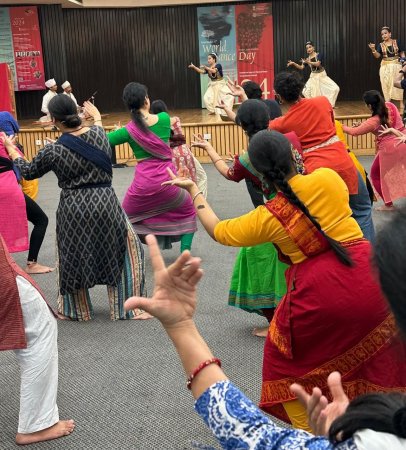 Sattriya workshop 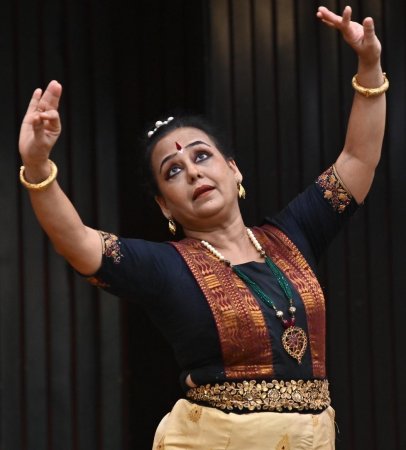 Prateesha Suresh Sattriya is the newest kid on the block in our galaxy of classical dances. Born in the Satras of Assam in the 15th century and largely a natya style of performance, its fluid movements and lyrical gestures embody both lasya and tandava themes while remaining gentle, graceful and controlled. Not for them the exuberance of the older classical styles or complex and vigorous footwork. It embodies the peaceful, Vaishnavite spirituality of Srimanta Sankardev (largely accepted as the chief composer and creator of the art) an acceptance through mind and body of the Lord and a surrender to his omniscient power. Prateesha Suresh has been trained in the highly stylised and vigorous classical art of Bharatanatyam. From a very young age she has also followed her passion, the art of Sattriya dance. Now as mentioned by her, she has begun codifying and recording a syntax for this traditional yet still extant form. The immersive Sattriya experience curated by Prateesha included lessons on the traditional movements and khol and cymbal rhythmic beats as well as the contemporary developments in dress and mudras. 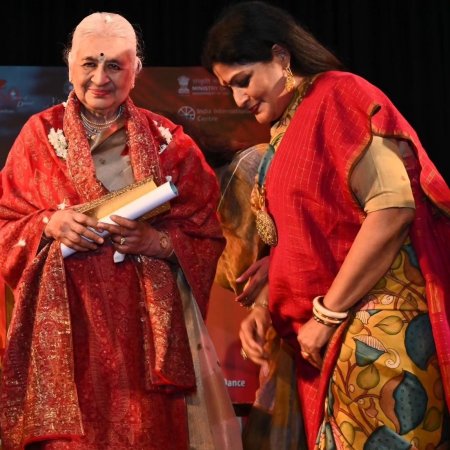 Leela Venkataraman & Geeta Chandran The award ceremony of the noted critic and dance commentator Leela Venkataraman who was given the Lifetime Achievement award by Natya Vriksha for the year 2024 in recognition of her work of over four decades on the traditional art and craft of dance followed in the evening. She leaves behind a weighty legacy of commentary, books and other materials in her journey where she has also been a Sangeet Natak awardee. 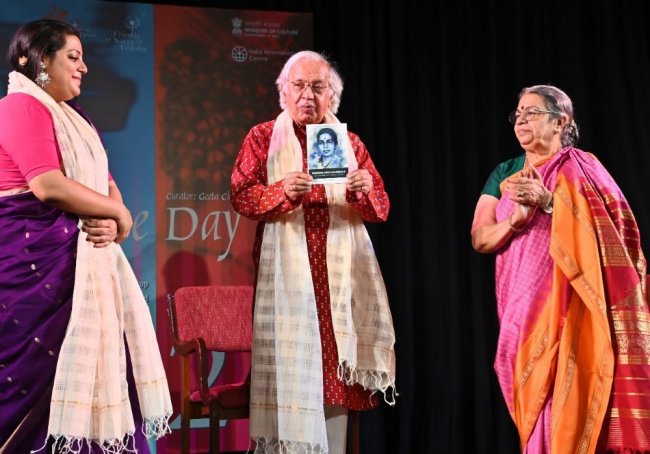 Publisher Trisha Niyogi, poet Ashok Vajpeyi, author VR Devika This was followed up by the release of a book on Rukmini Devi Arundale by the scholar VR Devika. A delightful monograph on her life, work and development of Bharatanatyam and the institution of Kalakshetra published by Niyogi Books, it touched upon her personal life, marriage, learning of an art form which was banned even from viewing for young women of a section of society and her influence on the developing art scenario of India at that time. Many of the adjectives recently being attributed to her work on Bharatanatyam such as appropriation, sanskritization, gentrification have been found debatable. However, what was not debatable is her immense contribution to building the foundations of modern India, her powerful legacy not only for the arts but what it means to be Indian especially during the national movement. The book was released by Ashok Vajpeyi. Roja Kannan has carried on the rich legacy of her Gurus, Adyar K. Lakshman and Kalanidhi Narayan in her performance and teaching and has passed them on to her young disciples Vaishnavi Srinivasan and Nivedha Harish. 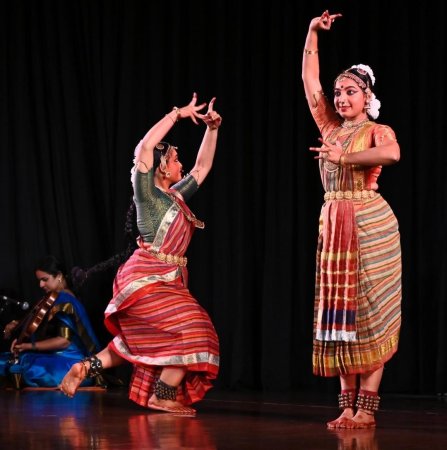 Vaishnavi Srinivasan and Nivedha Harish The first number performed by them was a choreographic composition by Adyar K. Lakshman in the year 1984 when he received his Padma Shri. It was dedicated to the five deities Ganesha, Muruga, Shiva, Durga and Vishnu and the music was based on the five gana ragas of Carnatic music by Madurai N. Krishnan. A composition wherein the traditional slokas are interspersed with jatis, it brought out the proficiency of the young artistes in all aspects of dance. Followed up by an exacting Swarajathi in raga Useni, tala rupakam this item was the result of a collaboration with the Late Lakshmi Vishwanathan who worked on a project on the Devadasis of Thanjavur. She recreated the performance of Devadasi Thanjavur Gnyana who in 1875 performed this Swarajathi in front of the Prince of Wales and the Nawab of Arcot. The original Kalakshetra jathis have been retained, the abhinaya progresses organically and the original movements of the hereditary dancers have also been retained. In the charanam the pancha nadai (five variations of tala) have been recreated by Guru Roja Kannan herself. Lakshmi Vishwanathan also took inputs from Jeetendra Krishna while working on this Swarajathi. The almost forty minute Swarajathi with the complex jathis ending in resonant teermanams are intertwined and equally balanced with the natya. The Nayika tells her Lord (the King) that she is bereft as he has left her for another woman. She wonders why he does not remember their happy times and what attraction does the other woman have for him. The young dancers did full justice to this complex and demanding number and it was a treat to see this piece of dance history so lovingly recreated and brought to the stage by Guru Roja Kannan. She was accompanied in her nattuvangam by Janani Narasimhan on vocals, M. Chandrasekhar on the mridangam and T.V. Sukanya on the violin. While Gurus are consolidating their legacy by preserving, recreating old items whilst allowing their students certain freedoms in adapting the technique to their own taste Dr Anita Ratnam felt that her legacy would be to digitalise and preserve this tradition (so long preserved by word of mouth) for posterity. More than her performing and teaching experience she felt that technology has come at the right time and she has been one of the pioneers in using it to both create and preserve content. 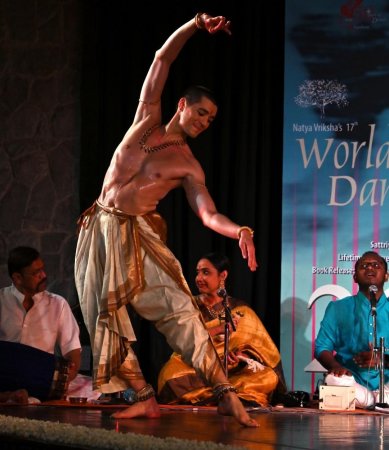 Thomas Vo Tan Tao Guru Neena Prasad, a powerhouse of learning and talent is using her legacy in creating a new one. The world of the male dancer in Mohiniattam, so long thought to be a purely female territory. Her student Thomas Vo Tan Tao is the bearer of this legacy though he is not the first male dancer of Mohiniattam but its first serious professional performer. His performance was in margam to showcase to the audience how the male body adapts and appears in this purely lyrical style. The starting number was Chollkettu set to Misrajati Triputa talam, an invocatory piece on Ganesha in raga Gambhiranattai. The graceful and soft yet sweeping body movements of Mohiniattam were a delight. This was followed by a Sthava Varnam of Swathi Thirunal where the protagonist is just a devotee. The music has been reset by vocalist Madhavan Namboodri, "Rama ava akhila ripu virama" in raga Sankarabharanam and adi tala. The interpretation of 'ripu' or enemy here is man's own arrogance. The sancharis describe the ego clash between Arjuna and Hanuman while they are crossing a setu. It is a story from an old folk fable. In the second sanchari "Kama manjima haari charurupa," Thomas portrays Kamadeva amusing himself in natural surroundings absorbed narcissistically in his own beauty. However, he is dismayed to find his beauty pale in comparison to Rama. Abhinaya is the main stay of this piece delicately portrayed by the performer. Next was the padam "Aliveni endu cheyvu" by Swathi Thirunal in raga Kurunji set to misra chapu talam. Here is a nayika desperate for the attention of her lord, Padmanabha. While her sakhis try to comfort her, the beautiful moon, the cool sandalwood scented breeze and the jasmine flowers make her more desperate for the Triloka Sundaram whose love she craves. Without him her existence has no meaning. Neena Prasad in her choreography has given importance to the nuances of the literary text and has ensured that the feelings expressed by the poet in his work are also expressed by the dancer rather than enhancing only the situational context that the poet is writing about. The agony of the nayika is highlighted as was the poet's intent. The last number was a Thillana set to music by Madhavan Namboodri in raga Tilang and talam roopak, The Thillana starts slow paced as per convention and picks up as it goes into the mei adavus and then onto the fast paced korvais. In this part of the evening, on the vocals we had Ananta Murali, on the mridangam Ramamoorthy Kesavan, and on the violin VSK Annadurai. 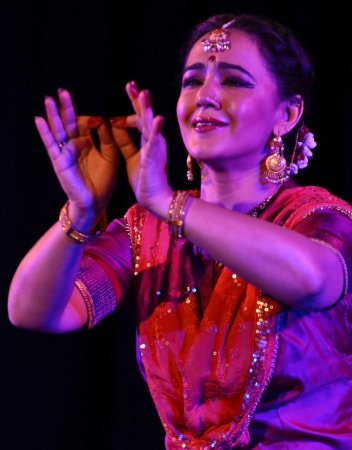 Divya Goswami The lively rhythms of the Thillana brought me to the Bandishes performed the previous evening by Divya Goswami in teental (sixteen matras). Starting with vilambit laya many of the bandishes were in Late Guru Munna Shukla's style.Showcasing the dancer's virtuosity and control over tala and laya through pure footwork is unique to the Kathak style. The Lucknow gharana softens this vigorous display of nritta with graceful hand movements, facial expressions and nowadays more mobility over the entire proscenium. Divya uses all of this to her advantage. She intersperses facial expressions, neck movements, eyebrow movements, chakkars, utplavanas. Her tatkar was rarely in a static posture. Moving from vilambit to druta laya, including popular bandishes in the Kathak style but with her unique flavour, the tukras, parans in seven, nine, five matras came in quick succession. A unique kayda with a dohar tehai was an interesting addition. She concluded with a rela in high speed closing with a round of mesmerising chakkars. Divya had begun her evening with an unusual Mangalacharan composed on a poem by Fazal Shah, the Punjabi poet. The poem describes one's first love as the love of the divine which results in a total surrender of the self. An Urdu poem for a mangalacharan was a break from tradition, the dance format and choreography held the stamp of legacy from Divya's teachers Yogini Gandhi and Guru Munna Shukla. Her accompanying brilliant team of musicians had Praveen D Rao on the tabla, Siddharth Bellamanu on vocals. Keerthi Kumar on padhanth. 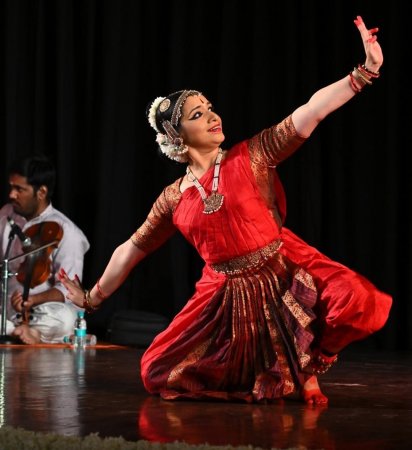 Meera Sreenarayanan Meera Sreenarayanan, a disciple of Guru Indira Kadambi, concluded the two day celebrations with a display of Bharatanatyam Margam. She maintained her Kalakshetra training at the same time being inspired by Indira Kadambi to create her own inimitable style. As Indira Kadambi said, the purpose of a guru is not only to pass on a rigid tradition but also create space for young artistes to discover themselves. She began with Dhyana shloka which as the nomenclature signifies helps in focussing the mind. A short beautiful piece, it was followed up khanda jati Alarippu, the first and invocatory dance of the margam. The Varnam came next, titled "Daniké," composed in the ragam Todi, a memorable work created by Nattuvanar Sivanandam Pillai of the Tanjore Quartet. The lyrics extol the admirable qualities, refined manners, and cultured tastes of Maharajah Sivaji and two Tanjore courtesans. A sophisticated courtesan pleads with the Maharajah on behalf of another courtesan all the while expressing her own passionate longing for the king and praising him. "Daniké" celebrates the longing for love. The lyrics convey a passionate tale of intense feeling while retaining humour using subtle wit and innuendo. The Varnam offers ample room for the dancer to express emotions through movement. Meera uses this to her advantage, using both her body and face to convey the deep emotions evoked by the wonderful poetry. Many of the abhinaya sequences may be considered overt rather than subtle and understated as we are used to in Bharatanatyam today, but here Meera is speaking the language of a Tanjore courtesan and contextually the gestures would be appropriate. Her nritta is vigorous with each korvai offering new delights of stylised footwork. The jatis and abhinaya sections of the varnam have been composed by Indira Kadambi with guidance and inputs from Jeetendra Krishna. This was followed by a Tulsidas bhajan written in Sanskrit and Awadhi, "Shri Rama Chandra Kripalu Bhajamana". A popular bhajan, the dance composition moved away from the mere descriptive nature of the poem to Rama's mother Kaushalya and how she sees Lord Rama who was highly venerated but to her was just a son returning after fourteen years of exile. A moving composition, Meera did well in her depiction of a mother's love, grief, longing and resignation to fate. The music was set to raga Yaman Kalyani and mishra chapu tala. Meera concluded with a Thillana in raga Simhendramadhyamam to matya tala wherein both music and dance were composed by Guru CV Chandrashekhar. This Thillana did not build up slowly with neck, eye or shoulder movements. It started with footwork and movement covering the proscenium which made it interesting and a revelation in using a traditional number with variations in choreography. She was accompanied by Himanshu Srivastava on nattuvangam, Bijeesh Krishna on vocal, VV Charudutt on the mridangam, and G Raghavanedra Prasad on the violin. After two days of intense exposure to the various aspects of dance in sum: Legacy is alive and well! The river of tradition is flowing full and strong adding newer streams to its depth and yet not breaking its banks to run amuck! A strong training in technique, syntax and style from one Guru is essential if one is to hold one's own as a performer or if one wishes to create one's own style. The same is true for commentators on dance. Training and performance experience is essential if one is to feel the nuances of performance art. Mere watching, appreciating and getting joy out of it as a pastime are not enough. Last but not the least, dance brings joy. Reason enough to celebrate. This celebration was made possible by Natya Vriksha and its founders Geeta Chandran and Rajiv Chandran. 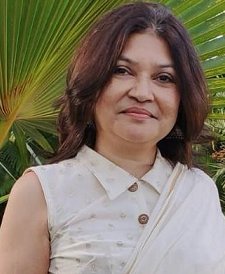 Sunita Chowdhurie interprets and analyzes performing and visual arts alongside her highly demanding corporate career. She has been trained in Bharatanatyam and Kathakali. |